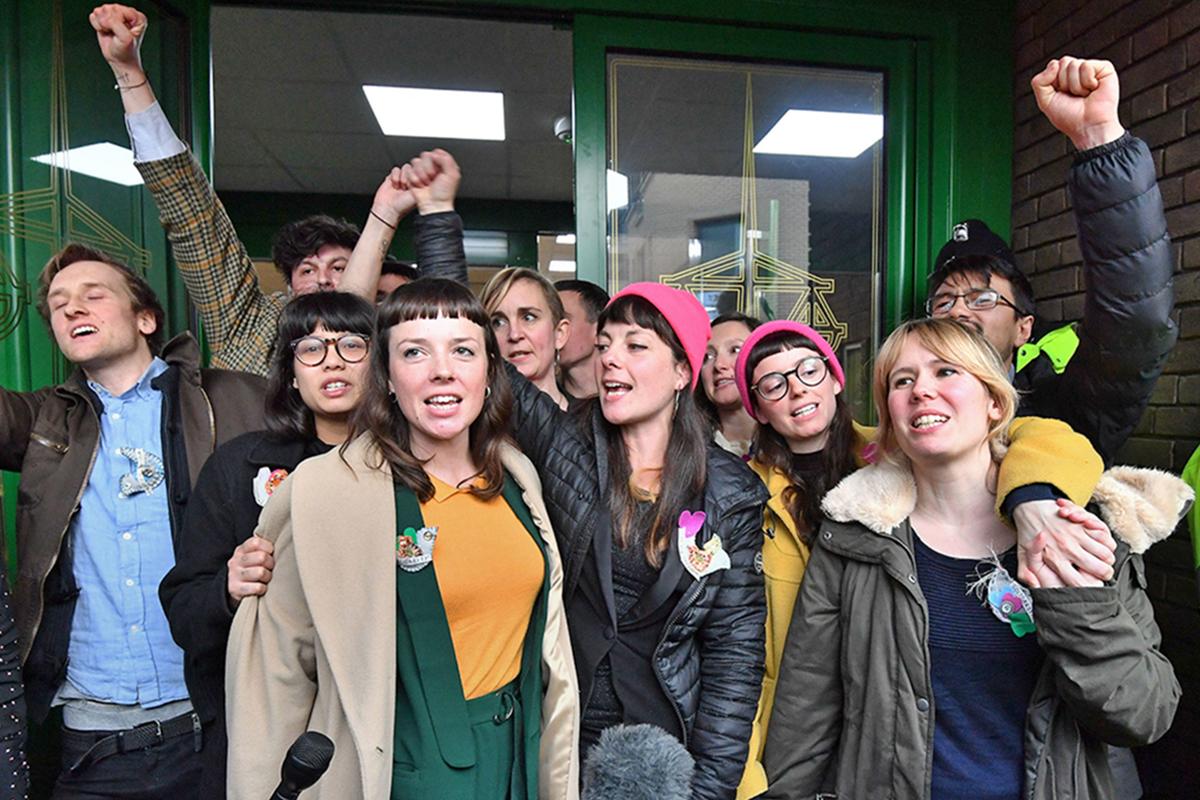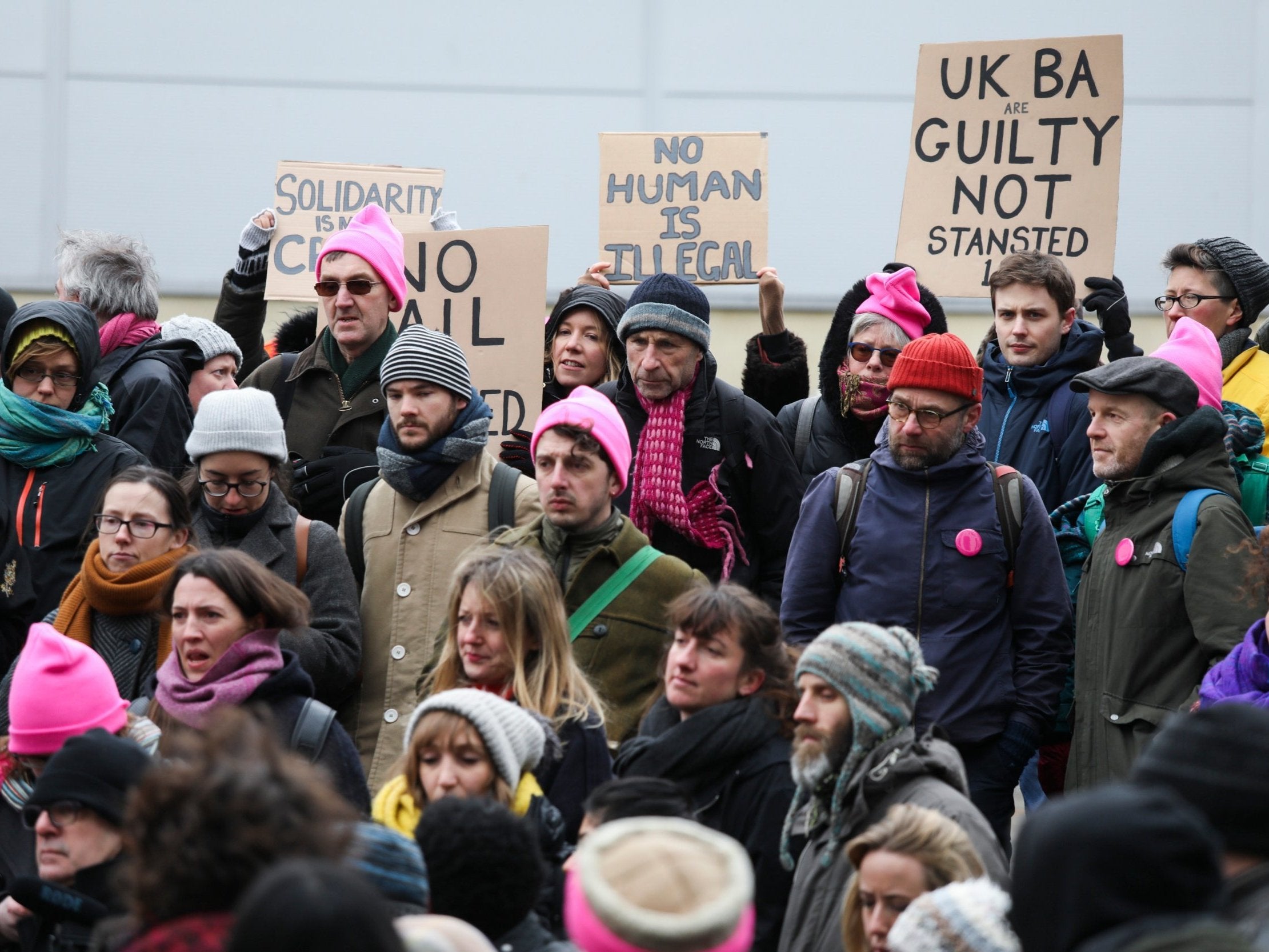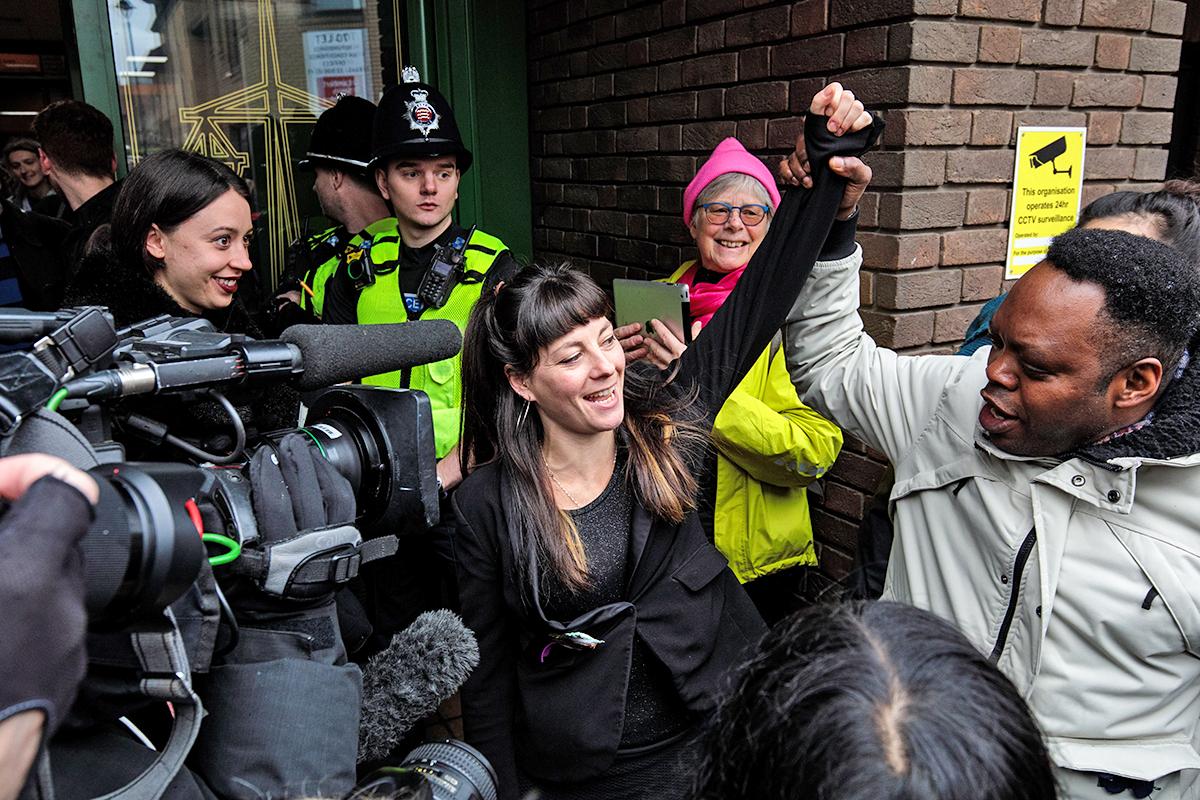‘I was arrested with the Stansted 15’
When protesters stopped a deportation flight at Stansted Airport in 2017, The Independent’s Casper Hughes was with them, documenting their direct action as a journalist. Now, he tells their story


Through the perimeter fence of Stansted, ominously lit up no more than 150 metres away on the airport’s apron, stands a Titan Airways Boeing 767 aeroplane.
The plane is due to fly that night to west Africa, deporting 60 people classed as illegal immigrants by the Home Office. Tied to their seats with waist-restraint belts and with shackles on their ankles, the 60 wait in a nearby coach.
On the other side of the airport, with the plane in sight, 15 activists pile out from the back of a minibus. They are there to stop the flight. They are the Stansted 15.
I am there too, camera in hand, to document their attempt.
My camera now in position, someone cuts a hole low down in the perimeter fence with bolt croppers.
Crouching, the protesters begin going through one by one. Those with bags on their backs – carrying the equipment they need to lock themselves together around the plane – get snagged on parts of the chopped fence and need to be pushed through. Getting stuck is another second lost in the race to the plane before they are apprehended. Tensions are excruciatingly high.
Once everyone has passed through I follow them, my camera jolting about as I jog across the grass to keep up. Three of the activists go to the front of the aircraft where over the next five minutes they will lock themselves to each other around the plane’s front wheel.
I follow the other 12, who congregate at the side, in between the wing and the stairs up to the rear of the plane. By now, people preparing the flight for boarding have seen us and it becomes clear they are contacting airport security.
Yet there is still no sign of anyone arriving to stop the attempt.
Over the next five minutes, a tripod is erected displaying a banner with the sign “no one is illegal”. The activists lock themselves together with padlocks inside large ceramic tubes underneath the tripod, with one positioning herself on top of the structure.
The police arrive before the last activist has had time to lock himself to the rest. He’s chased around the plane’s rear staircase by two officers before diving on to the bundle of bodies to try and attach himself. He is yanked away and arrested. The other protesters remain in place around the plane.
The plan had been months in the making. Passionate campaigning had fallen short of stopping a similar flight to west Africa in January. Protests outside the Nigerian embassy and Heathrow-based detention centres Harmondsworth and Colnbrook, as well as online Twitter “storms” and coordinated phone calls to Titan Airways had not been enough to prevent the deportations from going ahead. Out of this failure, grew the idea to take the protests further.
Helen Brewer, one of the 15, who was later to sit atop the tripod during the group’s action, had exchanged contact details with Tunde, one of the men who had been deported back to Nigeria in January. She had hoped to keep in touch with him on his return to the country.
“He was terrified to go back because he had family that were killed by Boko Haram in the north,” says Brewer. She was later to find out he had been kidnapped and left homeless by the terrorist group.
“We were lucky to hear from him again – many lose touch completely.”
Tunde’s story, and the testimonies provided by the charity Detained Voices of those due to be deported on the flight in March – including one woman who believed her husband would kill her on her arrival back in the country – became etched in the minds of the 15. For the activists, the desperate situation of those who were to be removed from Britain against their will required desperate measures.
“It was at that point we realised we needed to stop the flight,” says Brewer.
By tracking flight data and gathering inside information from detainees, Brewer and a few others were able to ascertain that the next deportation flight to leave the UK for west Africa was at the end of March and would leave from Stansted. Reconnaissance was carried out at Stansted in the dead of night to size up the task.
The group realised there was a short window of opportunity when the plane was being prepared for boarding that would allow them to get onto the apron and stop the flight.
In 2017, Home Office policy dictated that detainees were given just five days notification before their deportation takes place. It’s in this time where lawyers are hastily rung, in desperate attempts to appeal the Home Office decision to deport. This short time limit – shortened even further if it runs over a weekend – is hardly ever enough time to launch a successful appeal. Lucky for some on the flight due back to west Africa in March 2017 however, this five-day notice period also gave the Stansted 15 a defined date for their planned disruption.
By preventing the aircraft from taking off, the 15 hoped that those due to be removed would be given more time to process their cases and, if successful, stay in the country. Two of those who were due to be on the flight that night have since been given the right to remain. Eleven others are still in the UK and fighting their cases with the Home Office.
Campaigns against mass deportation charter flights aren’t new. But since their inception in 2001, no activist group had breached the security of an airport to stop a flight. Perhaps unsurprisingly, the success of the Stansted 15 in carrying out their plan (which had major consequences for the Home Office) has seen a swift reaction from the government.
Deportation flights are now taking place from a broader range of airports (including Bournemouth, Doncaster Sheffield and Birmingham), with the military airbase at RAF Brize Norton used on five occasions. Their dispersal around the country has made them increasingly difficult to detect and obstruct. The Home Office no longer gives detainees five days notification in advance of their removal from the country.
As the night of 28 March wore on, the bundle of bodies who had attached themselves together in the shadow of the plane slowly became fewer. Cut away in a painstaking police operation, one by one they were taken to Harlow police station.
As for me, I was arrested almost immediately that night. Pleas of “you can’t arrest me, I’m a journalist” don’t get you very far when you’re airside at a major airport in the midst of a protest. What’s more, I hadn’t yet got myself a press card then. I was in the middle of an internship at The Independent at the time and had pitched the story to a busy news editor in passing that afternoon.
Being painted as terrorists was really scary on a personal level. We were completely peaceful – we wore pink for God’s sake
I, therefore, had to spend 24 incredibly dull hours in a cell, while editors at The Independent confirmed I was indeed a journalist. The camera I was using to film the events had been taken away, although I had kept hold of the memory card. My hope was that I’d be released quickly and be able to email the footage to The Independent. By the time I was released, the story was already old news.
A few months later I was summonsed to attend Chelmsford Crown Court along with the activists. The charge initially brought against us all was for aggravated trespass (thankfully mine and the photographer Kristian’s was later dropped), typical for cases where protesters disrupt airports. Climate activists who launched direct actions at Heathrow and London City airport were prosecuted under the same act, and had received conditional discharges and in some cases small fines.
However, in the summer of 2017, the Crown Prosecution Service (CPS) asked the government’s chief legal adviser, attorney general Geoffrey Cox, to sanction an upgrade of the charge. Aggravated trespass was now to be “endangering an airport” under section one of the Aviation and Maritime Security Act 1990.
Although the charge doesn’t directly mention terrorism, the law was codified in response to the Lockerbie bombing in 1988 and was specifically implemented to deal with terror suspects. The secretary of state for transport of the time, Cecil Parkinson, argued during the second reading of the bill that it would be “another valuable weapon in the battle [against terrorism]”, specifically citing the first clause as dealing with “what are essentially terrorist acts at airports … making it an offence under law to carry out armed attacks at international airports … to cause damage and disruption.”

While the 15’s actions were not seen by the CPS as acts of terrorism, the law included clauses that they argued the defendants had fallen foul of. By entering airside of the airport and attaching themselves together using quite hefty equipment, the 15 had, according to the prosecution case, intentionally “disrupted the services of an aerodrome in such a way as to endanger or be likely to endanger the safe operation of the aerodrome or the safety of persons at the aerodrome”.
The charge came with a maximum sentence of life in prison. “Using a sledgehammer to crack a nut” was the term used by Amnesty International’s UK director Kate Allen. The stakes were suddenly a lot higher.
The reasoning behind the CPS’s decision is as yet unknown but a lack of transparency has led to a level of suspicion among the activists and the communities that support them that the move was aimed at crushing opposition to the government’s “hostile environment” policy.
“I think they are really trying to clamp down on any protest of this nature,” says Brewer. “Specifically [those that are] against the secretive nature of charter deportation flights.”
The defence’s pleas to the judge to be shown the justification for the decision to upgrade the charge have so far fallen on deaf ears.
It wasn’t just the updated charge that led to sleepless nights for the 15; it was also a change to the trial’s location. If their legal team had been magically allowed to choose the area in which the trial was to be held – bearing in mind the 15 had been accused of breaking the law to stop immigrants being deported – Chelmsford would have been pretty far down the list.
A majority in Chelmsford and the surrounding areas had voted to leave the European Union, with immigration high up on voters’ lists of concerns. The subsequent selection of an all-white jury compounded the 15’s anxiety about how their action would be perceived in court.
Broadly, the prosecution’s argument was this: the presence of the activists airside at Stansted, and the threat perceived by the police and members of staff who dealt with their actions, constituted a danger to the safety of the airport and those inside it.
The defence’s response was that the protesters’ actions – attaching themselves together underneath a stationary plane on the airport’s apron – had been undertaken with care, and (as demonstrated by the night’s peaceful events) not put anyone in danger.
They further argued that – as evidenced by the testimonies they had received from Detained Voices outlining the immediate danger some of the deportees were to find themselves in upon their return “home” – their actions were justified because they had saved lives. The hope was to put the spotlight back on the Home Office’s actions, and show that civil disobedience was required to block an unjust deportation regime from causing harm.
The prosecution’s first witness to the stand was a pilot who had been tasked with preparing the flight for boarding when the activists made their way on to the apron and towards the plane. He described a swarm of people running towards him in dark clothing and his concern that the group had planted something on the flight.
When we got the message they had a verdict on the first day of deliberation my stomach dropped. The fact that after nine weeks it only took them seven hours to deliberate and come to their decision tells a lot
He also said he saw some of the protesters running towards the runway, which the defence was able to cast doubt on using the footage that I had taken that evening. According to Brewer, this dramatic testimony was decisive in connecting their actions with a potential terrorist threat. “The prosecution used a lot of inflammatory language to describe us as a group,” she says.
“Being painted as terrorists was really scary on a personal level,” says Lyndsay Burtonshaw, another of the activists. “We were completely peaceful – we wore pink for God’s sake.”
The prosecution tried to show that those who had dealt with the 15 on the night were unclear of the motives behind the action.
“They called numerous police officers who told pretty much the same story, but who failed to mention or couldn’t remember why we were there,” says Brewer. “This is despite the phrase ‘No one is illegal’ being emblazoned on our jumpers and a large pink banner, and us saying on numerous occasions that ‘we are here to stop this plane and this is a peaceful direct action’.
“Our lawyers picked up on that but it kind of fell into the narrative they were trying to make, which was that we were a group of unknown people, we could have been dangerous though we weren’t, but that doesn’t matter because it feeds into the ‘likelihood of endangering’ based on someone fearing us, based on what we could have potentially done.”
One of the prosecution’s other arguments was that the defendants hadn’t read the airport’s safety manual and were, therefore, clearly a danger to themselves and others airside.
“To counter this, our defence was to go into the detail about all the precautions we took before embarking on the action,” says Brewer.

“But the prosecution would just rip that apart constantly. ‘Why didn’t you do this? And why didn’t you do that? Why weren’t some of you wearing hi-viz?’ etc etc.”
For the 15, the action had stemmed from their belief in the unjustness of the Home Office’s charter flight policy. But by the time their defence began in court, they had been roped into a protracted and technical argument about safety. This wasn’t the terrain on which they wanted to fight this case.
As Brewer puts it: “The prosecution presented it as a health and safety matter: ‘These people broke into the airport, the airport is a secure place, they didn’t work at the airport and didn’t read the airport safety manual, therefore they are guilty of endangering the safety of the airport.’ It was like, ‘no the case isn’t that black and white and not that simple.’”
On top of this, the jury didn’t appear to be reacting favourably to the defence’s justification arguments. The defendant’s emotive statements about the plight of prospective deportees simply weren’t sticking. As the trial went on, the lack of a connection became clearer.
“I did see the jury tutting, probably thinking ‘they’re talking about saving lives again’,” says Burtonshaw.
“Some people think that asylum seekers don’t face this amount of actual peril – it’s not dramatisation. People actually die!”
Brewer says: “A lot of our strategy was to try to present as humans, and as not extraordinary people. We were trying to create a connection and form a relationship with the jury, where they would come to realise that ‘oh we’re not so different’ and if ‘I was in your position I would have done the same thing’. It was hard to do that. Most of the time I was in the dock, I felt like I was looking at blank faces.”
Morale among the 15 had been steadily falling as the trial progressed and their arguments seemingly failed to gain traction, but the biggest blow was to come from the judge. After weeks of passionate defence, explaining their moral reasons for their actions, Judge Christopher Morgan QC instructed the jury that the justification argument the defence had used throughout their testimony was inadmissible.
“None of these matters have any relevance,” Morgan was to say. The case was now to rest solely with the specifics of the endangerment charge. The wind was knocked out of the defence’s sails.
“When we got the message they had a verdict on the first day of deliberation my stomach dropped,” says Brewer. “The fact that after nine weeks it only took them seven hours to deliberate and come to their decision tells a lot.”
The 15 were unanimously found guilty of endangering the safety of an airport under the 1990 Aviation and Maritime Security Act. Since the result, there has been a lot of soul-searching as to where it went wrong. From a trial they had expected to win easily, the 15 had suddenly found themselves looking at a potential prison sentence.
After the hammer blow of the judgment in December, Wednesday’s sentencing was, therefore, a huge relief. No custodial sentences were given by the judge, who accepted there were “genuine reasons” for their actions. Hours of community service across the board felt like a small victory for the 15, given the alternative possibilities.
Yet the group remains adamant that they should not have been found guilty in the first place – and they remain hopeful that the conviction might be overturned on appeal.
And this is not only about doing it for their own sakes. A successful appeal could have ramifications for the right of others to protest against deportations, as well as raising questions about the legitimacy of the Home Office’s deportation system itself.
“I have high hopes,” says Brewer. “Public support and interest in the case goes to show how important this is.
“It’s hugely important for the way protesters are charged and prosecuted in the future. We have to ask why it was used now? Why not against past actions on runways?”
The fight is obviously very far from over.